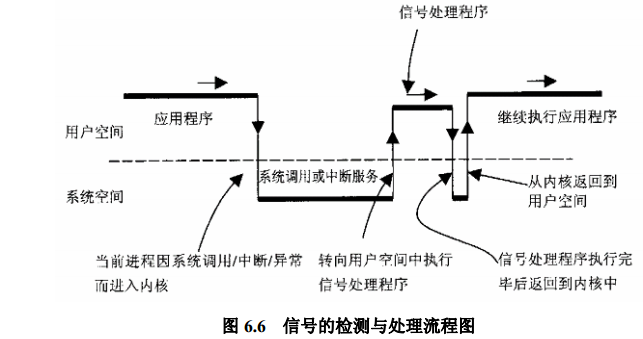摘要: 信号在进程间通信是异步的,每个进程的task_struct结构有一个sig指针,指向一个signal_struct结构定义如下 structsignal_struct { atomic_tcount; structk_sigaction action[_NSIG];//类似一个信号向量表,每个元素就是一个函数指针 spinlock_tsiglock; };
信号在进程间通信是异步的,每个进程的task_struct结构有一个sig指针,指向一个signal_struct结构
定义如下
structsignal_struct {atomic_tcount;structk_sigaction action[_NSIG];//类似一个信号向量表,每个元素就是一个函数指针spinlock_tsiglock;};
structk_sigaction {structsigaction sa;};
structsigaction {unsignedintsa_flags;__sighandler_tsa_handler;sigset_tsa_mask;void(*sa_restorer)(void);intsa_resv[1];/* reserved */};
由此可见,每个信号向量除了指向一个信号处理函数,他还可以是2个其他特殊的常数
/* Fake signal functions */#defineSIG_DFL ((__sighandler_t)0)/* default signal handling */#defineSIG_IGN ((__sighandler_t)1)/* ignore signal */#defineSIG_ERR ((__sighandler_t)-1)/* error return from signal */
由于SIG_DFL得数值为0,当向量表为空白时,所有信号向量对被视为SIG_DFL
信号向量与中断向量不同的是:中断向量表在系统空间,每个中断向量所指向中断响应程序也在系统空间,但虽然信号向量表在系统空间,但这些向量指向的信号处理程序缺在用户空间.
对于信号的检测和响应总是发生在系统空间,发生情况:当前进程系统调用,中断,异常而进入系统调用,从系统调用返回到用户空间的前夕.第二,当前进程在内核中进入睡眠后刚被唤醒的时候,由于信号的存在(处于未决状态)提前返回到用户空间.
具体来分析下sigaction结构体
structsigaction {unsignedintsa_flags;__sighandler_tsa_handler;sigset_tsa_mask;//屏蔽,一个64位的类型void(*sa_restorer)(void);intsa_resv[1];/* reserved */};
这里_sa_handler与_sa_sigaction都是函数指针,数据类型__sighandler_t定义为void(*)(int)指针,可见二者只是调用时的参数表不同,ra_restorer弃用.但sa_mask与sa_flags两个字段扮演着重要的角色.
sa_mask是一个位图,每一位对应一种信号,如果位图某一位设置为1,就表示执行当前信号的处理程序期间,要将相应的信号暂时屏蔽,使得执行过程中不会嵌套响应那种信号,特不是不管图的相应位设置为1,当前信号总是屏蔽自己,使得对同一种信号不会嵌套发生,除非sa_flags设置为SA_NODEFER或者SA_NOMASK标志为1
task_struct的信号队列与信号位图合并到一起了
structsigqueue {structsigqueue *next;siginfo_tinfo;//挂载信号相关信息};
structsigpending {structsigqueue *head,**tail;//挂载队列sigset_tsignal;//位图,信号要处理时,设置为1};
structtask_struct {intsigpending;//表示该进程是否有信号需要处理intexit_code,exit_signal;/* Protects signal and blocked */structsignal_struct *sig;//指向具体的信号处理动作sigset_tblocked;//阻塞structsigpending pending;//位图+信号队列}
结构分析完了,接下来看看信号的安装
intdo_sigaction(intsig,conststructk_sigaction *act,structk_sigaction *oact){structk_sigaction *k;if(sig <1||sig >_NSIG ||(act &&(sig ==SIGKILL ||sig ==SIGSTOP)))//不允许对此信号安装信号处理函数return-EINVAL;k =¤t->sig->action[sig-1];//获取该信号的旧信号处理函数spin_lock(¤t->sig->siglock);if(oact)*oact =*k;//获取老的信号具体操作if(act){*k =*act;//获取新的信号处理操作,将阻塞位sigkill跟sigstop删除(不允许屏蔽)sigdelsetmask(&k->sa.sa_mask,sigmask(SIGKILL)|sigmask(SIGSTOP));/** POSIX 3.3.1.3:* "Setting a signal action to SIG_IGN for a signal that is* pending shall cause the pending signal to be discarded,* whether or not it is blocked."** "Setting a signal action to SIG_DFL for a signal that is* pending and whose default action is to ignore the signal* (for example, SIGCHLD), shall cause the pending signal to* be discarded, whether or not it is blocked"** Note the silly behaviour of SIGCHLD: SIG_IGN means that the* signal isn't actually ignored, but does automatic child* reaping, while SIG_DFL is explicitly said by POSIX to force* the signal to be ignored.*/if(k->sa.sa_handler ==SIG_IGN||(k->sa.sa_handler ==SIG_DFL&&(sig ==SIGCONT ||sig ==SIGCHLD ||sig ==SIGWINCH))){spin_lock_irq(¤t->sigmask_lock);if(rm_sig_from_queue(sig,current))//如果设置的处理模式是sig_ign或者sig_del//而涉及的信号是上面3个,那就直接丢弃已到达信号recalc_sigpending(current);//是否有信号等待处理总标志位也需要再计算spin_unlock_irq(¤t->sigmask_lock);}}spin_unlock(¤t->sig->siglock);return0;}
rm_sig_from_queue丢弃已到达信号实现
/** Remove signal sig from t->pending.* Returns 1 if sig was found.** All callers must be holding t->sigmask_lock.*/staticintrm_sig_from_queue(intsig,structtask_struct *t){returnrm_from_queue(sig,&t->pending);}
其主体实现是rm_from_queue
staticintrm_from_queue(intsig,structsigpending *s){structsigqueue *q,**pp;if(!sigismember(&s->signal,sig))//表示该位是否已经置1,一般是已经,否则直接returnreturn0;sigdelset(&s->signal,sig);//清除该标志位pp =&s->head;while((q =*pp)!=NULL){if(q->info.si_signo ==sig){//如果队列中的信号等于sig(针对新类型信号)if((*pp =q->next)==NULL)s->tail =pp;kmem_cache_free(sigqueue_cachep,q);//删除atomic_dec(&nr_queued_signals);//-1continue;}pp =&q->next;}return1;}
查看发送信号处理
asmlinkage longsys_kill(intpid,intsig){structsiginfo info;//收集相关信息info.si_signo =sig;//信号类型info.si_errno =0;info.si_code =SI_USER;//用户信号info.si_pid =current->pid;//进程号info.si_uid =current->uid;//uidreturnkill_something_info(sig,&info,pid);}
/** kill_something_info() interprets pid in interesting ways just like kill(2).** POSIX specifies that kill(-1,sig) is unspecified, but what we have* is probably wrong. Should make it like BSD or SYSV.*/staticintkill_something_info(intsig,structsiginfo *info,intpid){if(!pid){//pid==0发送给当前进程的所有进程returnkill_pg_info(sig,info,current->pgrp);}elseif(pid ==-1){//发送到除当前进程以外的进程intretval =0,count =0;structtask_struct *p;read_lock(&tasklist_lock);for_each_task(p){if(p->pid >1&&p !=current){interr =send_sig_info(sig,info,p);++count;if(err !=-EPERM)retval =err;}}read_unlock(&tasklist_lock);returncount ?retval :-ESRCH;}elseif(pid <0){//小于值,则发送给-pid的进程组returnkill_pg_info(sig,info,-pid);}else{returnkill_proc_info(sig,info,pid);//发送给具体的进程}}
inlineintkill_proc_info(intsig,structsiginfo *info,pid_tpid){interror;structtask_struct *p;read_lock(&tasklist_lock);p =find_task_by_pid(pid);//找到pid对应的task_struct结构error =-ESRCH;if(p)error =send_sig_info(sig,info,p);//发送信号read_unlock(&tasklist_lock);returnerror;}
最重要部分send_sig_info
int//信号 信号相关信息 接收信号进程的pcbsend_sig_info(intsig,structsiginfo *info,structtask_struct *t){unsignedlongflags;intret;#if DEBUG_SIGprintk("SIG queue (%s:%d): %d ",t->comm,t->pid,sig);#endifret =-EINVAL;if(sig <0||sig >_NSIG)//不在信号范围出错gotoout_nolock;/* The somewhat baroque permissions check... */ret =-EPERM;if(bad_signal(sig,info,t))//进行错误检查gotoout_nolock;/* The null signal is a permissions and process existance probe.No signal is actually delivered. Same goes for zombies. */ret =0;if(!sig ||!t->sig)//如果信号为0或者,不存在对应操作gotoout_nolock;spin_lock_irqsave(&t->sigmask_lock,flags);handle_stop_signal(sig,t);//收到某些特定的信号,不可屏蔽一些其他后续信号,这个负责处理/* Optimize away the signal, if it's a signal that can behandled immediately (ie non-blocked and untraced) andthat is ignored (either explicitly or by default). */if(ignored_signal(sig,t))//如果响应是忽略,而且不用跟踪,没有屏蔽,那就不用投递信号gotoout;/* Support queueing exactly one non-rt signal, so that wecan get more detailed information about the cause ofthe signal. */if(sig <SIGRTMIN &&sigismember(&t->pending.signal,sig))gotoout;//老编制的信号,投递,就是把接收信号位图设置为1,不用将信号挂到队列ret =deliver_signal(sig,info,t);out:spin_unlock_irqrestore(&t->sigmask_lock,flags);if((t->state &TASK_INTERRUPTIBLE)&&signal_pending(t))//如果接收的进程处于这个状态,//而且有信号要处理,则唤醒进程wake_up_process(t);out_nolock:#if DEBUG_SIGprintk(" %d -> %d
",signal_pending(t),ret);#endifreturnret;}
staticintdeliver_signal(intsig,structsiginfo *info,structtask_struct *t){intretval =send_signal(sig,info,&t->pending);if(!retval &&!sigismember(&t->blocked,sig))signal_wake_up(t);returnretval;}
staticintsend_signal(intsig,structsiginfo *info,structsigpending *signals){structsigqueue *q =NULL;//创建一个相关嘟列/* Real-time signals must be queued if sent by sigqueue, orsome other real-time mechanism. It is implementationdefined whether kill() does so. We attempt to do so, onthe principle of least surprise, but since kill is notallowed to fail with EAGAIN when low on memory we justmake sure at least one signal gets delivered and don'tpass on the info struct. */if(atomic_read(&nr_queued_signals)<max_queued_signals){q =kmem_cache_alloc(sigqueue_cachep,GFP_ATOMIC);}if(q){atomic_inc(&nr_queued_signals);q->next =NULL;//新创建的,设置为null*signals->tail =q;//指向尾部signals->tail =&q->next;//switch((unsignedlong)info){case0:q->info.si_signo =sig;q->info.si_errno =0;q->info.si_code =SI_USER;q->info.si_pid =current->pid;q->info.si_uid =current->uid;break;case1:q->info.si_signo =sig;q->info.si_errno =0;q->info.si_code =SI_KERNEL;q->info.si_pid =0;q->info.si_uid =0;break;default:copy_siginfo(&q->info,info);//拷贝相关信息,到队列break;}}elseif(sig >=SIGRTMIN &&info &&(unsignedlong)info !=1&&info->si_code !=SI_USER){/** Queue overflow, abort. We may abort if the signal was rt* and sent by user using something other than kill().*/return-EAGAIN;}sigaddset(&signals->signal,sig);//将接收信号,相应位图设置为1return0;}
/** Note that 'init' is a special process: it doesn't get signals it doesn't* want to handle. Thus you cannot kill init even with a SIGKILL even by* mistake.*/intdo_signal(structpt_regs *regs,sigset_t*oldset){siginfo_tinfo;structk_sigaction *ka;/** We want the common case to go fast, which* is why we may in certain cases get here from* kernel mode. Just return without doing anything* if so.*/if((regs->xcs &3)!=3)return1;if(!oldset)//如果为0oldset =¤t->blocked;//获取其屏蔽信号for(;;){unsignedlongsignr;spin_lock_irq(¤t->sigmask_lock);signr =dequeue_signal(¤t->blocked,&info);//取出一个没屏蔽的信号spin_unlock_irq(¤t->sigmask_lock);if(!signr)//如果为0则跳出(因为表示当前没有这样的信号了)break;//如果当前if((current->ptrace &PT_PTRACED)&&signr !=SIGKILL){/* Let the debugger run. */current->exit_code =signr;current->state =TASK_STOPPED;notify_parent(current,SIGCHLD);schedule();/* We're back. Did the debugger cancel the sig? */if(!(signr =current->exit_code))continue;current->exit_code =0;/* The debugger continued. Ignore SIGSTOP. */if(signr ==SIGSTOP)continue;/* Update the siginfo structure. Is this good? */if(signr !=info.si_signo){info.si_signo =signr;info.si_errno =0;info.si_code =SI_USER;info.si_pid =current->p_pptr->pid;info.si_uid =current->p_pptr->uid;}/* If the (new) signal is now blocked, requeue it. */if(sigismember(¤t->blocked,signr)){send_sig_info(signr,&info,current);continue;}}ka =¤t->sig->action[signr-1];//获取信号向量if(ka->sa.sa_handler ==SIG_IGN){//如果对应的处理是SIG_IGNif(signr !=SIGCHLD)//忽略则继续取没屏蔽信号,处理continue;//是儿子信号则等待所有子进程退出/* Check for SIGCHLD: it's special. */while(sys_wait4(-1,NULL,WNOHANG,NULL)>0)/* nothing */;continue;}//信号向量设置为SIG_DFLif(ka->sa.sa_handler ==SIG_DFL){intexit_code =signr;/* Init gets no signals it doesn't want. */if(current->pid ==1)//不可以对init进程发送相关信号continue;switch(signr){caseSIGCONT:caseSIGCHLD:caseSIGWINCH:continue;//如果是SIGCONT之类,continue继续处理信号caseSIGTSTP:caseSIGTTIN:caseSIGTTOU:if(is_orphaned_pgrp(current->pgrp))continue;/* FALLTHRU */caseSIGSTOP://如果是sigstop信号current->state =TASK_STOPPED;//设置标志位current->exit_code =signr;if(!(current->p_pptr->sig->action[SIGCHLD-1].sa.sa_flags &SA_NOCLDSTOP))notify_parent(current,SIGCHLD);schedule();continue;caseSIGQUIT:caseSIGILL:caseSIGTRAP:caseSIGABRT:caseSIGFPE:caseSIGSEGV:caseSIGBUS:caseSIGSYS:caseSIGXCPU:caseSIGXFSZ:if(do_coredump(signr,regs))//这类信号默认处理exit_code |=0x80;/* FALLTHRU */default://多数信号的默认处理sigaddset(¤t->pending.signal,signr);//猜想设置此位表示默认处理,留给父进程查看信息recalc_sigpending(current);//检查进程是否有非阻塞的挂起信号current->flags |=PF_SIGNALED;do_exit(exit_code);//结束接收信号的进程/* NOTREACHED */}}/* Reenable any watchpoints before delivering the* signal to user space. The processor register will* have been cleared if the watchpoint triggered* inside the kernel.*/__asm__("movl %0,%%db7"::"r"(current->thread.debugreg[7]));/* Whee! Actually deliver the signal. */handle_signal(signr,ka,&info,oldset,regs);return1;}/* Did we come from a system call? */if(regs->orig_eax >=0){/* Restart the system call - no handlers present */if(regs->eax ==-ERESTARTNOHAND ||regs->eax ==-ERESTARTSYS ||regs->eax ==-ERESTARTNOINTR){regs->eax =regs->orig_eax;regs->eip -=2;}}return0;}

信号安装过程
获取旧的信号处理方法
同时安装新的信号处理方法,将信号处理函数掩码的阻塞位sigkill跟sigstop删除,返回旧信号处理方法
信号发送过程
siginfo收集发送信号当前信息(进程号,uid号,信号的对应数值)
如果响应是忽略,而且不用跟踪,没有屏蔽,那就不用投递信号
老编制的信号,投递,就是把接收信号位图设置为1,如果是第一次则挂载到队列,不是第一次则不用将信号挂到队列
接着创建一个队列结构,拷贝siginfo信号,同时将sigpending的signal位图设置为1,完成传递
处理过程(for循环,不断的获取已挂载但没阻塞的信号,直到没有为止)
获取信号向量,如果对应位是SIG_IGN,那就直接continue,是儿子信号则调用wait等待所有子进程退出
默认处理,一般直接退出
否则将调用用户自定义的函数

